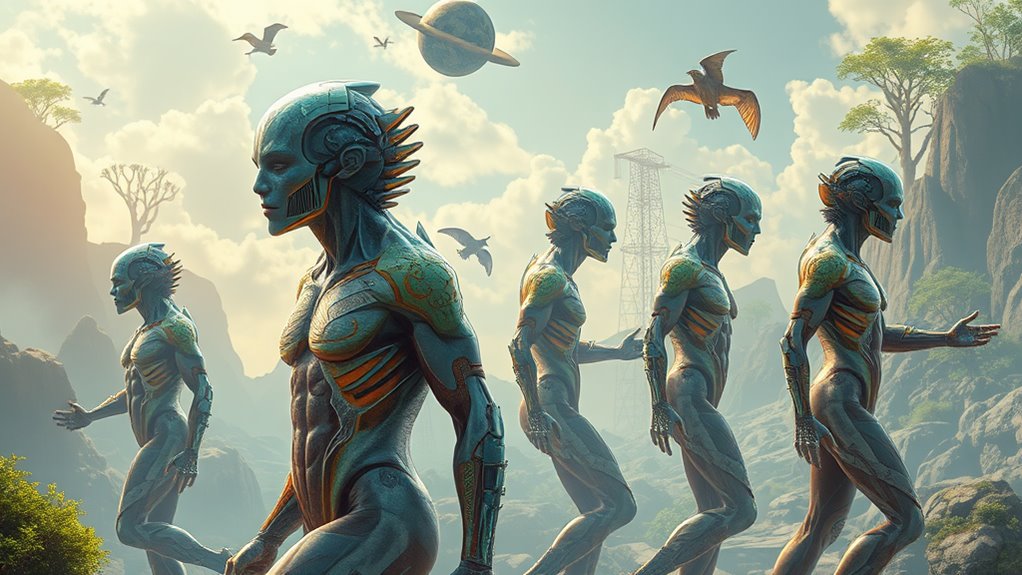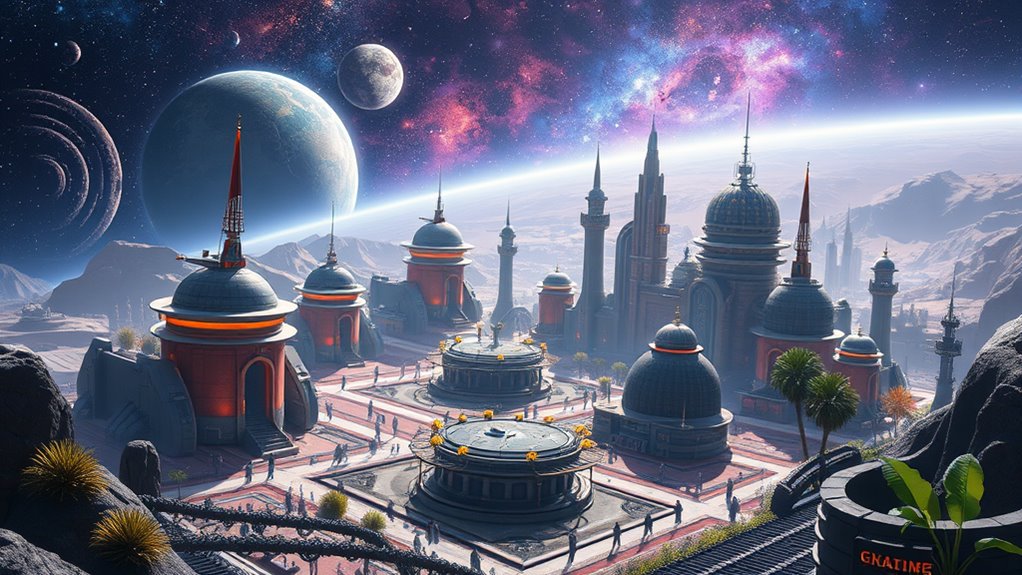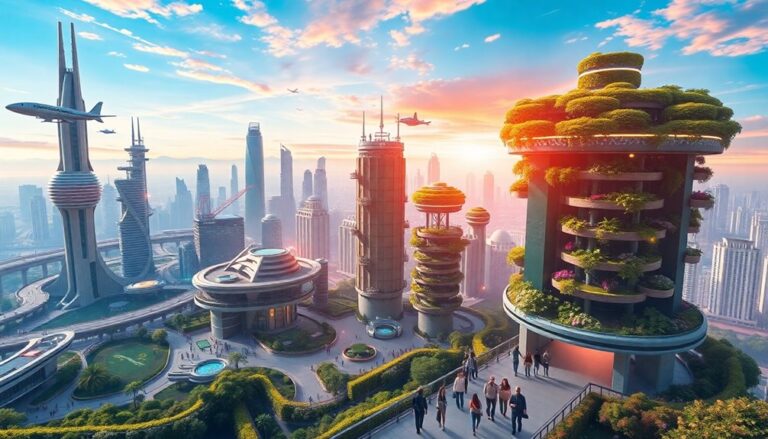In 1000 years, you'll see a world shaped by incredible technology and evolved societies. Your health monitoring will rely on wearable tech and AI that tailors treatments just for you. Transportation will be dominated by autonomous vehicles and hyperloops, making travel lightning fast and safe. Climate challenges will lead to floating cities and advanced agriculture techniques. Societal structures will shift, promoting global citizenship and decentralized governance. You'll even witness the beginnings of life on Mars, with lunar bases serving as launch pads for deeper space exploration. Curious about how these transformations unfold? There's much more to discover!
Essential Insights
- Humanity will have evolved physically, adapting to technology with changes like stooped posture and "tech neck," impacting overall health.
- Personalized medicine and AI-driven diagnostics will ensure tailored healthcare, allowing for real-time monitoring and predictive analytics for health issues.
- Environmental adaptation will lead to floating cities and advanced agricultural practices as communities respond to climate change and rising sea levels.
- Global citizenship and decentralized governance will foster diverse, meritocratic societies that value collaboration and cultural preservation.
- Space colonization efforts will result in lunar and Martian habitats, with advanced transportation systems enabling sustainable life beyond Earth.
Physical Evolution of Humanity

As technology continues to reshape our daily lives, the physical evolution of humanity is becoming increasingly evident. You might notice some troubling trends that reflect our evolutionary adaptations to a tech-centric world. For instance, constant smartphone and computer use can lead to a stooped posture, causing strain on your body and increasing your risk of long-term spinal damage. This habitual screen viewing alters your natural alignment, potentially resulting in chronic back problems.
Your hands and arms are also adapting to these technological impacts. You may develop what's known as "text claws," a condition caused by holding your smartphone for extended periods. Frequent texting can create awkward arm positions, leading to 90° angled elbows and muscular changes that might reduce your dexterity in other tasks. Additionally, the emergence of "smartphone elbow" reflects how modern communication habits affect our arm mechanics.
Moreover, consider the potential changes to your skull and brain. While it's theorized that technology could lead to larger skulls but smaller brains, significant reductions in brain size are unlikely without evolutionary advantages.
However, the thickening of your neck, often termed "tech neck," is a real concern, as constant screen use alters the muscles and structure of your neck.
In essence, these physical changes serve as a reflection of how technology influences our anatomy. As you navigate this digital age, keep in mind that your body is continually adapting, and the long-term implications of these technological impacts are still unfolding.
Technological Advancements Ahead

Technological advancements are set to revolutionize every aspect of life over the next millennium. You'll experience a world transformed by energy innovations and AI advancements that redefine how you live, work, and connect.
By 3017, fossil fuels will be relics of the past, replaced by renewable energy sources like solar and wind power. Imagine enormous space-based solar farms collecting energy and transmitting it wirelessly to your home. With advanced battery technologies, energy storage becomes more efficient, allowing you to power your devices with minimal waste. The future will see a significant shift in energy consumption as humanity progresses towards a Kardashev Scale rating of [0.5/6.]
Transportation will also see dramatic shifts. Hyperloops will let you zip between cities at over 1200 mph, making long-distance travel a breeze. Autonomous vehicles will dominate the roads and skies, handling navigation and safety without any human intervention.
Space travel will be an exciting reality, with trips to Mars being attainable, even if they still take weeks.
In the domain of computing, quantum AI will tackle problems that seemed impossible, reshaping industries from healthcare to finance. You'll find AI tailored to your personal or organizational needs, offering unprecedented predictive analytics for informed decision-making.
Holographic technology will change how you communicate, creating immersive experiences that make distant interactions feel real.
As these advancements unfold, your daily life will become more integrated with smart devices, enhancing your comfort and productivity in ways you can hardly imagine.
Embrace the future—it's going to be extraordinary!
Environmental and Climate Transformations

The world you inhabit in 3017 will be dramatically shaped by environmental and climate transformations that alter landscapes and lifestyles. You'll witness increased frequency and intensity of natural disasters, reshaping not just the land but also how communities live and adapt. Coastal cities may be submerged, with billions of dollars' worth of property at risk. You'll need to embrace climate adaptation strategies to survive and thrive in this new world. In fact, by 2050, an estimated $106 billion worth of coastal property could be projected below sea level, highlighting the urgent need for proactive measures.
As temperatures rise, you're likely to experience more extreme weather, with more days exceeding 90 degrees. This shift challenges your ecological resilience, pushing you to innovate new ways to sustain crops and manage resources.
- You'll rely on advanced agricultural techniques to combat declines in crop yields.
- Coastal communities may develop floating infrastructure to adapt to rising sea levels.
- Wildlife will face new challenges, and conservation efforts will focus on preserving biodiversity.
The loss of ecological diversity could lead to catastrophic changes in marine ecosystems, and you'll witness the struggle for survival in a world that's become increasingly volatile.
Efforts to achieve Net Zero Carbon Emissions by 2050 will be essential, but even then, the impacts of current CO2 emissions will linger for centuries.
In this transformed environment, your ability to adapt will be key. You'll need to find innovative solutions to guarantee that both human and ecological survival are possible, even in a world where nature's balance has been irrevocably altered.
Societal and Cultural Changes

Society in 3017 will undergo profound changes influenced by technological advancements and shifting cultural values. You'll find that the concept of global citizenship becomes increasingly prevalent as international collaboration and migration reshape identities. This shift could lead to cultural homogenization, but also the emergence of new, hybrid social structures that celebrate diversity. Social hierarchies will likely evolve from rigid systems to more fluid social structures. Meritocratic systems may dominate, with your status determined by individual achievement rather than birth or wealth. As decentralized governance models emerge, powered by blockchain and similar technologies, you'll notice a significant reduction in the influence of central authorities, empowering communities to make decisions collaboratively. Virtual communities will play a vital role in your social life, often rivaling physical interactions in importance. These online spaces will foster community engagement and create opportunities for diverse expressions of identity. As you navigate this interconnected world, cultural preservation efforts will utilize advanced technologies to document and protect traditional practices while promoting innovative forms of art and entertainment. In this new societal landscape, the emphasis on egalitarian structures will grow, prioritizing community well-being over efficiency. You'll witness large-scale public engagement, enabling residents to actively shape their cultural practices and identities. Moreover, the lessons learned from historical experiences, such as the impact of disease outbreaks, will guide contemporary public health policies and community responses. Together, these changes will redefine what it means to belong and participate in a rapidly evolving global society, encouraging a deeper understanding of one another amidst diversity.
Health and Medical Innovations

In 3017, health and medical innovations will revolutionize how you experience and manage your well-being. Imagine a world where gene therapy can't only treat but also prevent diseases before they manifest. With predictive analytics, you'll have access to real-time data that anticipates health issues, allowing you to take proactive measures.
You might enjoy:
- AI-Enhanced Health Monitoring: AI will monitor your health through sensors embedded in your body, flagging potential issues before they escalate.
- Personalized Medicine: Your treatment plans will be tailored specifically for you, thanks to advanced algorithms analyzing your unique genetic makeup.
- Remote Health Management: Routine check-ups and consultations will happen right from your home, with robotic surgeries available at a moment's notice.
Thanks to rapid gene sequencing, identifying dangerous mutations will happen at record speeds. AI-driven platforms will predict conditions like kidney and heart failure, ensuring you're always a step ahead. Additionally, advancements in quantum computing will allow for more complex simulations of human biology, leading to better treatment strategies.
The integration of generative AI in clinical settings could enhance patient outcomes greatly, making chronic disease management more effective than ever.
Nanotechnology will further transform healthcare, with nanobots monitoring your health in real-time, repairing tissues, and even combating pathogens in your bloodstream.
Together, these advancements in health and medical innovations will empower you to live a longer, healthier life, making wellness an integral part of your daily routine.
Space Exploration and Expansion

While you gaze up at the night sky, the thought of humanity's future in space becomes ever more tangible. By 2024, lunar habitats are set to emerge, serving as essential launch sites for manned missions to Mars and beyond. These lunar bases won't only support extended surface exploration but also act as critical stepping stones for deep space missions.
With advancements in 3D printing technology, the potential for creating Moon bases is becoming a reality, utilizing lunar resources like water to sustain human presence. NASA's focus on returning to the Moon emphasizes the importance of establishing these habitats as part of sustainable exploration efforts.
As you imagine this thriving lunar infrastructure, consider the development of the Space Launch System (SLS) and the Orion spacecraft, which are designed for deep space exploration. Reusable transportation systems and in-space propellant depots will revolutionize how we travel beyond our planet, making it more efficient and sustainable. Air transport technologies are also advancing to tackle the challenges of space exploration.
Moreover, the concept of space colonization is gaining momentum. Long-term plans include establishing large-scale colonies not just on the Moon and Mars but also on asteroids and dwarf planets. Innovative projects like space elevators will enable economical mass transportation of materials, equipment, and people, facilitating expansion.
Global cooperation is key to these ambitious goals. Partnerships between NASA, commercial entities, and international organizations are essential to overcoming financial and technological obstacles. As humanity looks to the stars, the dream of living and thriving beyond Earth is closer than ever.
Frequently Asked Questions
How Will Human Emotions Evolve in the Next Millennium?
How will you navigate the shifting landscape of human emotions in the coming millennium?
As emotional intelligence grows, you'll likely harness digital empathy to connect more deeply with others. Technology may enhance your ability to recognize and express emotions, reshaping how you relate to the world.
New emotional responses will evolve, adapting to societal changes, ensuring that your capacity for love, joy, and even sorrow continues to flourish amidst innovation.
What Role Will Art and Creativity Play in Future Societies?
Art and creativity will be crucial in future societies, driving community engagement and cultural preservation.
You'll see digital art and augmented reality merging to create immersive experiences that foster creative collaboration.
With artificial creativity on the rise, you'll explore new forms of artistic expression that challenge traditional boundaries.
These innovations won't only enhance personal connections but also deepen your understanding of diverse cultures, making art an indispensable tool for societal growth and unity.
How Might Family Structures Change in the Coming Centuries?
Imagine a tapestry woven with vibrant threads of blended families, where digital parenting guides the next generation.
In the coming centuries, you'll see communal living becoming the norm, fostering connections among neighbors.
As genetic diversity flourishes, family structures will evolve, embracing varied backgrounds and traditions.
Your support network might grow beyond traditional boundaries, creating a rich fabric of relationships that adapts to the needs of modern life, ensuring everyone thrives together.
Will There Be New Forms of Entertainment in 1000 Years?
New forms of entertainment are evolving, and you'll find yourself immersed in virtual reality like never before.
Picture interactive storytelling where artificial intelligence tailors experiences to your preferences. Holographic performances will dazzle you, while sensory entertainment engages all your senses.
Gamified learning transforms education into an adventure, enhancing social connectivity as you share these experiences with others.
The possibilities are endless, making entertainment more engaging and personalized than you've ever imagined.
How Will Spirituality and Religion Adapt Over Time?
Spirituality and religion will adapt by embracing virtual spirituality, allowing you to connect with diverse practices and communities online.
You'll find transhuman beliefs emerging, blending technology with spiritual growth, as you explore new dimensions of consciousness.
As society evolves, these adaptations will offer personalized paths, fostering deeper connections to the divine and each other.
Your spiritual journey will likely reflect these changes, integrating innovative practices that resonate with the modern world.
